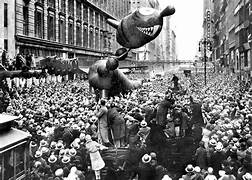The Macy's Thanksgiving Day Parade, a beloved American tradition, has been enchanting spectators since its inception in 1924. What started as a modest procession has transformed into a grandiose spectacle, becoming an integral part of the Thanksgiving celebration for millions of people across the United States. In 1924, the first Macy's Thanksgiving Day Parade was organized by Macy's employees who were primarily European immigrants. The idea was to celebrate Thanksgiving and Christmas, ushering in the holiday season with a festive event that would bring joy to the community. The inaugural parade featured live animals borrowed from the Central Park Zoo, marching bands, and employees dressed in vibrant costumes. It was a whimsical procession designed to lift the spirits of New Yorkers still recovering from the effects of World War I. One of the parade's highlights was the introduction of giant balloons in 1927. Felix the Cat was the first-ever character balloon, setting the stage for a tradition that would captivate generations. Over the years, the balloons have evolved to include beloved characters from popular culture, ranging from Mickey Mouse to Snoopy. These enormous helium-filled figures floating above the streets of New York City have become synonymous with the parade. Throughout the Great Depression, the Macy's Thanksgiving Day Parade continued to march on, providing a source of hope and cheer during challenging times. The parade's popularity soared, making it a nationally recognized event. Radio broadcasts and newspaper coverage brought the magic of the parade to households across the country, solidifying its status as a Thanksgiving institution. The parade was briefly suspended during World War II due to rubber and helium shortages, as these materials were crucial for the war effort. However, it made a triumphant return in 1945, marking the end of the war and symbolizing a return to normalcy. The 1950s and 1960s saw the parade embrace new technologies, with the introduction of televised broadcasts. This allowed an even broader audience to experience the magic of the event. The addition of marching bands, celebrity performances, and Broadway show excerpts enhanced the parade's entertainment value, making it a must-watch event for families nationwide. In the 1980s, the parade faced challenges due to inclement weather and the potential risk of the giant balloons becoming uncontrollable. This led to the implementation of safety measures such as size restrictions on the balloons and the introduction of specialized handlers. Over the years, the Macy's Thanksgiving Day Parade has become a platform for promoting entertainment and pop culture. It has featured performances from some of the biggest names in music, Broadway, and television. The spectacle has consistently adapted to the times while retaining its timeless charm, making it a multi-generational tradition. In recent decades, the parade has embraced technology with the inclusion of high-tech floats, augmented reality experiences, and live streaming options, ensuring that audiences worldwide can join in the celebration. The Macy's Thanksgiving Day Parade remains a symbol of joy, unity, and the festive spirit that defines the holiday season in the United States. Each year, millions eagerly await the procession of colorful floats, marching bands, and iconic character balloons that gracefully dance above the streets of New York City, marking the official start of the holiday season.
1924 U.S.A. — Macy’s Thanksgiving Day Parade
